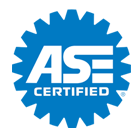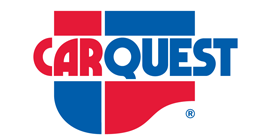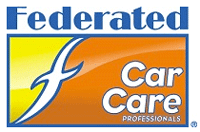Slipping into Fall (Driving with ABS Brakes)
Posted March 28, 2021 8:18 AMAs the weather changes over from hot to colder, drivers will have to deal with more slippery streets. And it's important to know how to drive with the brakes you have on your vehicle.
In the 1970s, anti-lock braking systems (ABS) started to be installed on vehicles and they've been a game changer for drivers. Most modern vehicles have ABS and it's important to know how to drive with them.
In older vehicles without ABS, the driver applies the brakes by pushing down the pedal. That, in turn, sends braking pressure to all four wheels at once. But all four tires don't have the same traction because the road surface they're each on isn't exactly the same.
ABS allows sensors to determine when particular wheels are slowing down more quickly. The ABS then reduces braking pressure to the wheels that are about to lock up. That way the wheel turns and the tires keep some grip. (You have to have grip to stop.) It's kind of what drivers try to achieve when they pump the older-style brakes without ABS.
Another engineered feature of ABS is that it makes sure your front wheels will continue to rotate and maintain some traction. That's important because the front wheels are used to steer, and being able to steer gives a driver more control in a quickly-changing situation. So ABS is all about stopping as fast as the road surface will allow but at the same time enabling the driver to maintain control.
ABS is designed for the driver to put steady pressure on the brake pedal and let the vehicle’s computerized system handle the braking. Pumping the pedal in a vehicle with ABS can defeat what the system is trying to do to help you maintain control.
Because stopping techniques in a vehicle with ABS are different than those without, it’s important to know which brakes you have so you can operate them accordingly.
If you have any doubt, consult your service advisor. ABS involves sophisticated technology and must be maintained in order for it to work properly. Your service advisor can recommend a maintenance schedule for you to follow so your ABS is always on the ready to help you stop when you need to.
All Things Automotive & Diesel Service
1997 Walton Ave #C
Idaho Falls, ID 83401
208-523-3903
Some New Boots (Suspension Maintenance)
Posted March 21, 2021 7:42 AMThere are some boots that don't come in a shoe box and aren't worn on your feet. They are called axle or CV boots, and they can be important parts for many vehicles.
That CV stands for constant velocity. CV axles are mainly used in front-wheel drive and all-wheel drive vehicles. They're also used in some rear-wheel drive vehicles with independent suspensions. They have two CV joints, one inner and one outer, placed between the axle and the drive wheels. That way the vehicle's engine power can drive the wheels, no matter what angle they are. They also adjust for the different speeds wheels turn as they go around corners.
Because roads are full of all sorts of hazards (dirt, oil, water, grime), these CV joints need to be protected. They also have grease in them to keep the bearings moving smoothly. That's the job of the rubber boots that are supposed to keep that debris out. These CV or axle boots are made of rubber or plastic and usually last a long time without any problem. But sometimes they fail, either from being hit by debris or age causing the rubber or plastic to deteriorate. That can allow the grease to leak out of the joint and the moisture to get in. And that's where the trouble is.
So it's important to have a vehicle's CV boots checked periodically, especially when they begin to have more than 100,000 miles/160,000 kilometers on them. A technician inspects them for tears or cracks. Sometimes if the problems are found early enough, the boots can be replaced and the joints can be re-packed with grease.
But sometimes the CV joint can wear out even though the boot is intact. When the CV joint fails, you might hear a grinding, humming or clicking noise and feel vibration.
Some of these can be difficult to access for service, so many service advisors will recommend replacing the joints and boots at the same time. Just remember, new CV boots won't make a fashion statement, but they will keep your vehicle going down the road for years to come.
All Things Automotive & Diesel Service
1997 Walton Ave #C
Idaho Falls, ID 83401
208-523-3903
Don't Neglect Your Spare (Spare Tire Care)
Posted March 14, 2021 10:00 AMIf you've ever had a flat tire, then you know welcome it is to have a spare tire that is properly inflated, in good shape and easy to get to. Problem is many of us don't even give our spare tire (if we even have one) a second thought.
If you have an SUV or truck with a spare, it may be mounted outside the vehicle, such as on the tailgate or underneath the vehicle. All of them, especially those underneath, take the brunt of debris, moisture, salt and dirt from the road surface, a potpourri of corrosion potential. The hardware that holds these on can rust into a solid mess, making it hard for you or even a roadside assistance service to get off.
If you have one of those, have it checked and maintained at your vehicle repair facility on a regular basis. They should be lubricated and cleaned periodically, and some recommend doing this service every time you have your tires rotated. If the spare is the same size as the tires on the vehicle, it may be a good idea to have it rotated with the others.
Some vehicles have compact spares that are in a small well in the trunk or some other spot. Most drivers don't pay any attention to them. Over time, air leaks out of those spares, leaving them flat when you most need them. When you have your vehicle in for service or routine maintenance, ask your service advisor for his or her advice on making sure the spare is inflated properly and cleaned, usually at least twice a year.
You may not know it, but your vehicle may not have any spare at all. Instead, it may have an inflator kit that you are supposed to use to inflate and seal a flat tire. That sealant has a limited life span and should be replaced every few years. Check with your service advisor to make sure the kit is up to date and will do the job when called upon.
Manufacturers know a flat tire's always a possibility. No matter what contingency solution they've included with your vehicle, keep it in shape and in good working order. When you need it, you'll be very glad you did.
All Things Automotive & Diesel Service
1997 Walton Ave #C
Idaho Falls, ID 83401
208-523-3903
Greeted by a Screech (Loud Noise when Starting Vehicle)
Posted March 7, 2021 8:27 AMNo one likes to be greeted in the morning by having someone screech at you. The same goes for a loud, high-pitched noise your vehicle greets you with every time you start the engine. If you're wondering if that's normal, no, it isn't. And it is worth getting checked out. The good news is that it might be nothing serious. Then again, it may be.
The first things to suspect any time you hear a high-pitched sound coming from the engine are belts. They have tension on them and they're trying to turn lots of different pulleys, pumps and other equipment the engine needs to work properly. The noise could come from the belts starting to wear out and dry out. If one of those belts breaks at an inopportune time, not only can it strand you somewhere, the damage to the engine could be very expensive to fix.
Other things that will cause a high-pitched sound are the pulleys and tensioners. The tensioners keep the right amount of pressure on the belts and some pulleys contain rubber that dampens engine vibrations. The rubber in the pulleys can crack or deform with age, which prevents them from working correctly and may cause your belts to wear out.
A technician will check to see if the belts are worn or cracked. He or she will also check the tension on the belts, the condition of the pulleys and whether all components are aligned the way they should be.
Sometimes, the noise is nothing major to worry about, but it's still worthwhile to rule out any problems that have cropped up now or may appear in the future. You'll have a properly running vehicle that sounds like its engineers intended… quiet and smooth.
All Things Automotive & Diesel Service
1997 Walton Ave #C
Idaho Falls, ID 83401
208-523-3903















